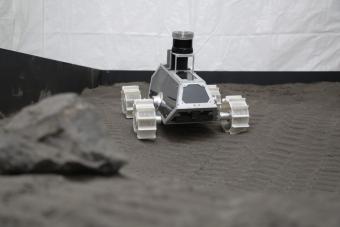Lunar test bed a playground for emerging space technology
Almost 50 years to the day since astronauts collected the first geologic samples from the Moon, we tackle a few questions about Mines' new lunar test bed and how it fits into the future of space exploration.

What does a lunar test bed look like? For many of us, probably a bit like a great big sandbox — if that sandbox were filled not with play sand but finely ground basaltic cinders meant to simulate the dusty regolith that covers the surface of the Moon.
For Christopher Dreyer, research assistant professor in Colorado School of Mines’ Space Resources Program, though, it looks like the future.
“Fifty years after Apollo 11, plans are being made to return to the Moon. The way we will return and stay is by the use of resources on the Moon,” Dreyer said.
Almost 50 years to the day since astronauts Neil Armstrong and Buzz Aldrin collected the first geologic samples from the lunar surface, we’re tackling a few questions about the new Mines Lunar Testing Facility and how it fits into the future of lunar exploration.
What is regolith, really?
Simply put, it’s Moon dirt. The mix of powdery dust, broken rock and other materials forms the top layer of the lunar surface.
“There are two types of lunar surfaces — one is called mare and the other one is called highlands,” Dreyer said. “The Mines test bed simulates the mare regions, or the Earth-facing dark areas of the Moon.”
How is regolith simulated here on Earth?
Over six Apollo missions, astronauts brought back to Earth about 842 pounds of lunar rocks, core samples, pebbles, sand and dust.
From those samples, scientists have since developed a number of simulants that roughly match the chemical composition, mineralogy, particle size, distribution and engineering properties of the real deal, for use in experiments both big and small.
Mines went to Arizona’s Merriam Crater to source the material for its lunar simulant, the same location NASA has used in the past. Mines researchers purchased 20 tons of basaltic cinders mined from the volcanic ash deposit, for use in the test bed and other specific experiments.
The cinders then had to be milled down from 8 millimeters in diameter to about 150-200 microns to better approximate the Moon’s dusty top layer. That work was done on campus at the Earth Mechanics Institute, where the test bed also resides.
“NASA has test beds all over, at Kennedy, JPL, Marshall, Johnson Space Center, to test robotics, the mechanics of traversing a surface like this, drilling into it, excavation,” Dreyer said. “Our thought was, why can’t we be the university that has a test bed, too?”
The test bed itself is roughly 6 feet by 12 feet in size, with about a foot and a half of material. Beneath the fine top layer are the larger 8-milimeter cinders.
“The lunar surface isn’t just the fine stuff,” Dreyer said. “"There are rock fragments and layering of the subsurface. Depressions represent impact craters — if we were to turn it into a real lunar impact crater, it would have blown-out material from the impact and some of the material below would be glassy. Building a test bed is about getting the right simulant but also about creating a right simulated environment.”
Who is the test bed for?
Dreyer envisions three main user groups for the facility: faculty working on space resources research, student groups preparing for competitions such as the NASA Mars Ice Challenge and small businesses looking to test emerging technology.
“Today, small businesses do not have a location where they can test their lunar technology. It takes time and investment to build their own test bed, learn how to make a good lunar simulant and keep it replenished,” he said.
Companies have already started taking Dreyer up on the offer. For Lunar Outpost, a Colorado-based aerospace startup, having access to the test bed has been crucial to the development of their lunar rover, MAPP, said CEO Justin Cyrus MS ‘16.
“The high-quality lunar regolith simulant is a differentiator that most other facilities cannot match,” said Cyrus, who is also a PhD student in the Space Resources Program at Mines. “That along with access to other crucial facilities at Colorado School of Mines Center for Space Resources, including TVAC and cryochambers, and the storied expertise of the faculty and researchers, makes the new Lunar Testing Facility truly a valuable asset for the Colorado aerospace community and the aerospace community as a whole.”
What’s the future?
In two words: space resources. Those resources could include the water trapped in the Moon’s permanently shadowed regions — capable of being made into rocket propellant — minerals, metals or even solar energy. Before they can be extracted and used in space, though, lunar rovers, lunar drills and more will need to be developed and tested here on Earth.
Dreyer and Angel Abbud-Madrid, director of the Center for Space Resources at Mines, for one, are part of a project recently funded by NASA to develop lunar sample acquisition technology. They will be adapting the penetrometer work done by recent Mines PhD graduate Jared Atkinson to be used on a MAXAR robotic arm to make measurements of the lunar surface.
Improvements to the Mines test bed are on the horizon, too. Dreyer said he would love to someday get the Mines facility up to the same level as NASA’s Swamp Works at Kennedy Space Center.
“At Swamp Works, they have a large bed, probably 10 times ours, and it’s in a fully enclosed room ventilated with air scrubbers. They work in there only in full bunny suits and masks. It’s a very fine regolith — much finer than what we’re using right now — and it creates a lot of dust when you work with it,” Dreyer said. “We’re not there yet, but this is a start.”




